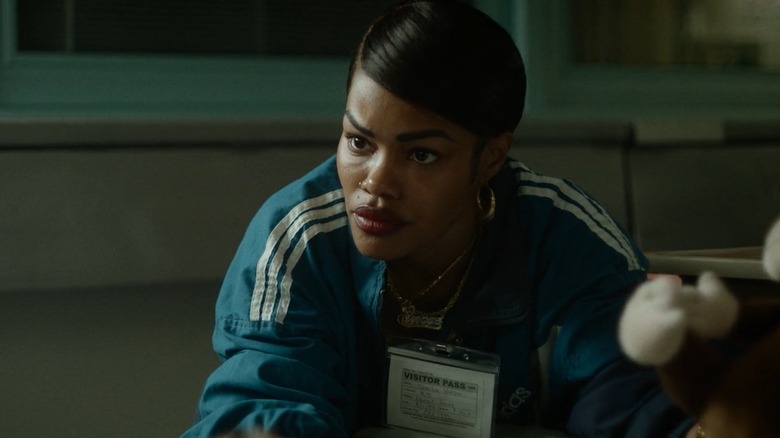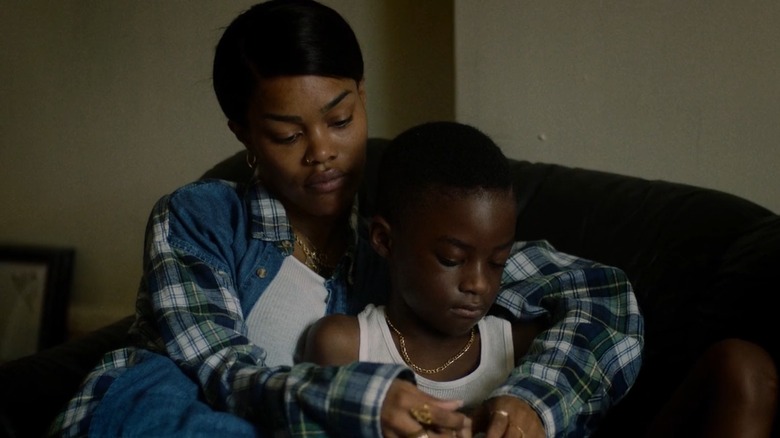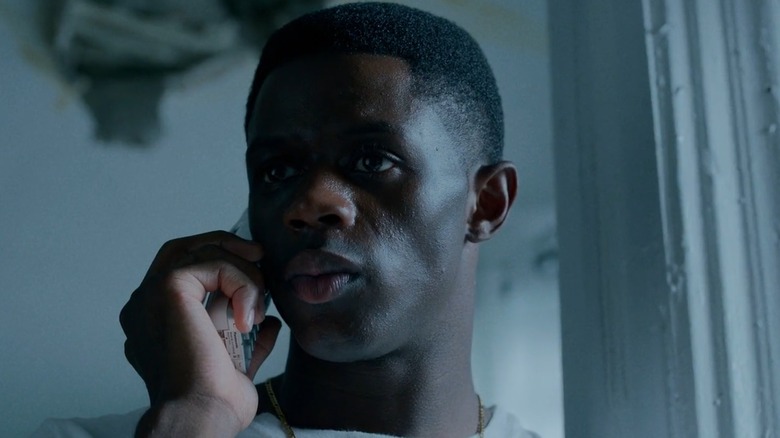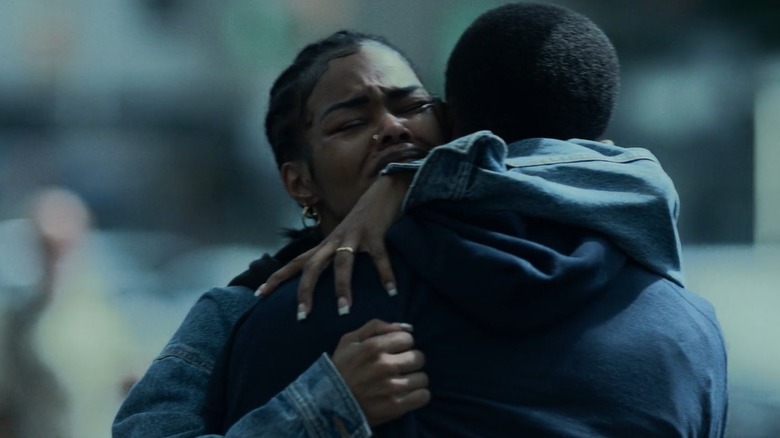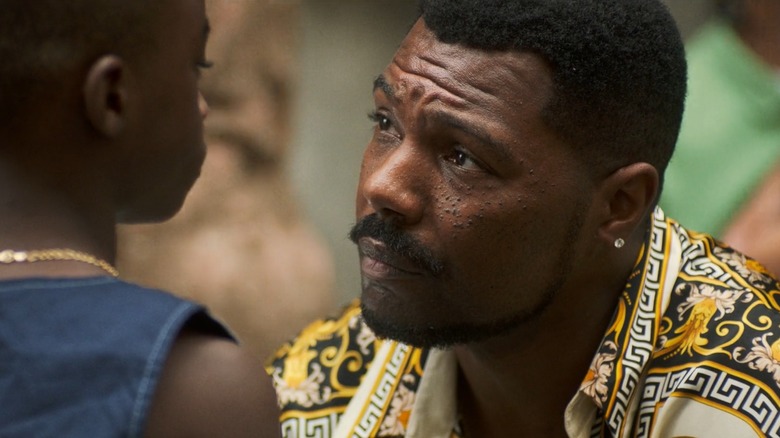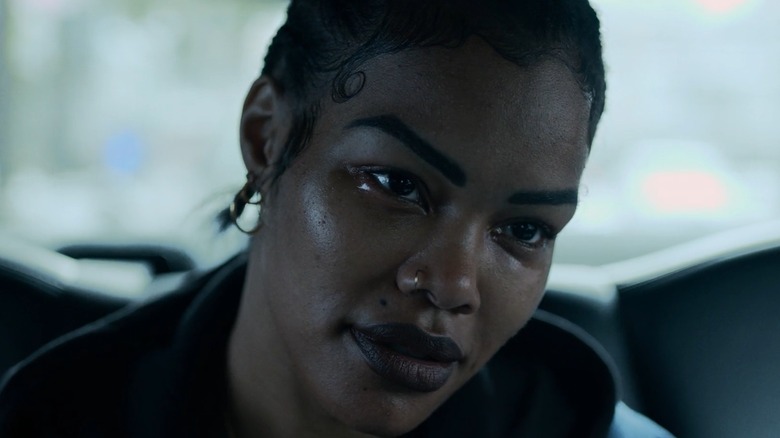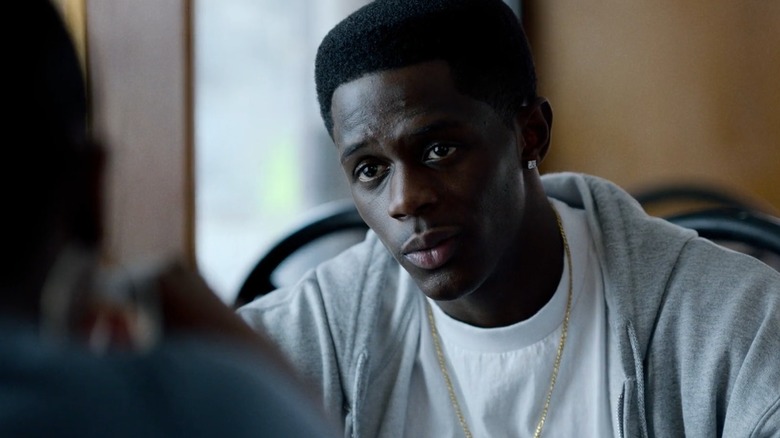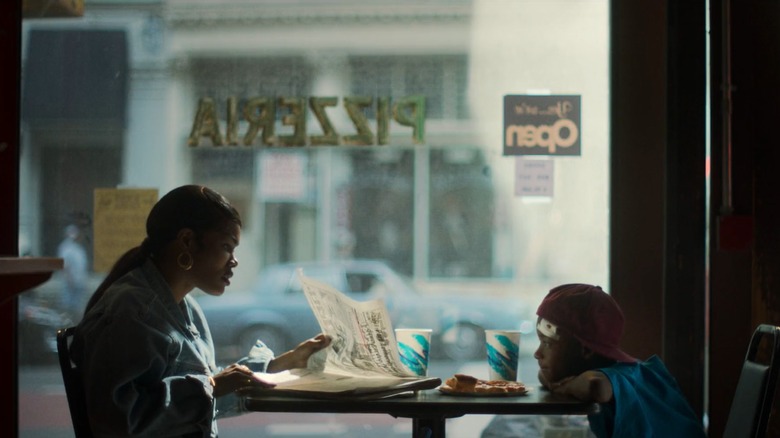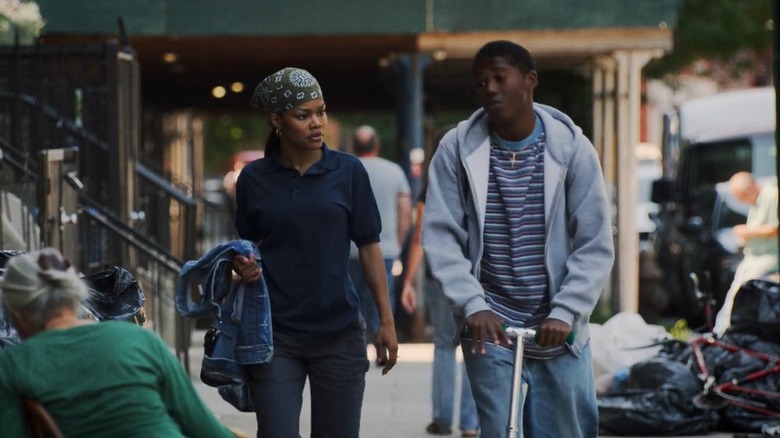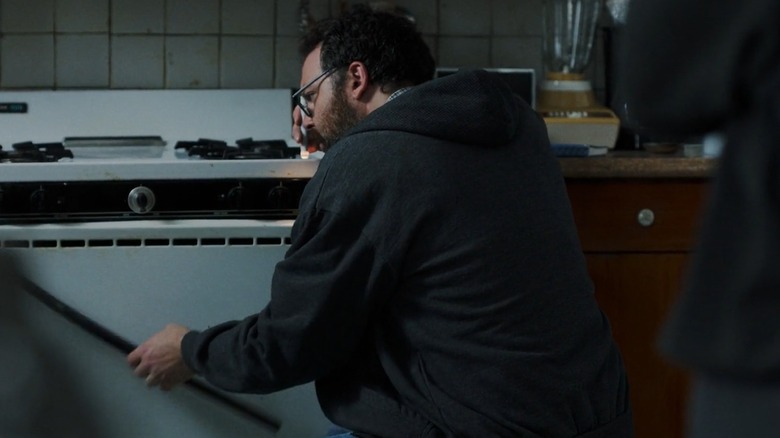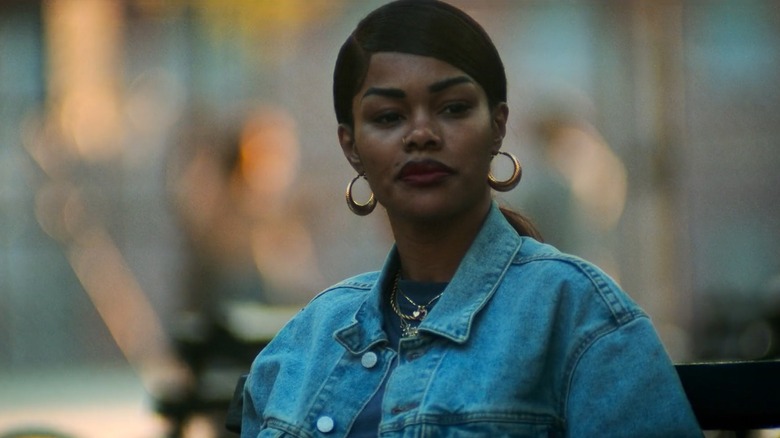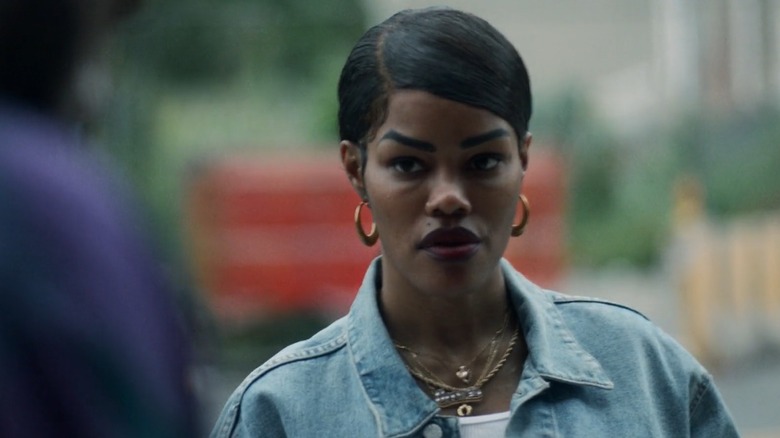The Ending Of A Thousand And One Explained
Teyana Taylor, so notable for her work as a singer, dancer and choreographer for the likes of Beyonce and Kanye West that she has been affectionately dubbed 'Spike Tee' after one of her idols, director Spike Lee, has been appearing intermittently on both sides of the camera for over a decade. Her most high profile film role, however, hit theaters in early 2023, marking the feature film debut of A. V. Rockwell.
"A Thousand and One" had already earned the Grand Jury prize at the Sundance Film Festival before its release, raising expectations. The film lived up to the hype, currently garnering a 97 percent fresh rating on Rotten Tomatoes. Audiences have been gradually discovering and discussing the film, with its ending making a particularly strong impression.
Characterized by its deliberate pacing, impressive writing, and memorable performances, "A Thousand and One" places a significant emphasis on character development. The characters played by Taylor and her co-stars serve as the heart and soul of the film and, while the plot is essential, explorations of these characters is paramount. With this in mind, read on for an explanation of the film's ending — and how the characters' decisions ultimately shape the world they inhabit.
What you need to remember about the plot of A Thousand and One
The movie employs time jumps reminiscent of "Moonlight," with the first jump occurring in 1994, followed by 2001, and finally 2005. Each year serves as an act that provides additional details about the characters that the audience didn't previously know.
Inez (Teyana Taylor) starts as a convicted criminal at Rikers Island. Upon her release, she attempts to rebuild her life, relying on her impressive hairdressing skills. One morning, she encounters a 6-year-old Terry (Aaron Kingsley Adetola) walking home from school. Filled with sadness, Inez approaches Terry and reveals that he is her son. She makes a solemn vow to him, promising to eventually remove him from the foster care system and care for him herself. After a night where Terry attempts to escape from yet another foster family, Inez reaches her breaking point and decides to abduct Terry, obtaining fake papers for him. Together with her new husband Lucky (Will Catlett) they embark on a journey to start a new life as a family.
In 2001, Terry, now 13 years old (Aven Courtney), becomes an impressive student, and his teachers suggest he should attend a different school to help reach his full potential. However, on the other side of Lucky and Inez's marriage, things are falling apart. They grapple with Lucky's absence and his infidelity.
As depicted in 2005, Lucky succumbs to cancer, and a long-held secret about Terry's true identity emerges, threatening to shatter the family.
What happens at the end of A Thousand and One
On his deathbed, Lucky makes a heartfelt attempt to discuss college choices with the now 17-year-old Terry (Josiah Cross). However, Terry hasn't yet made up his mind about the future. In a poignant moment, Lucky imparts a valuable lesson to Terry, emphasizing that opportunities like these were rarely available to people from his era. He urges Terry not to take these chances for granted, and to be mindful of their significance. As a parting gift, Lucky presents Terry with his old vinyl records and encourages him to cherish them.
Following Lucky's passing, Terry begins to seriously contemplate his life's direction. He requests his birth certificate and social security number, intending to apply for a job. On the same day, he musters the courage to ask out his crush Simone (Alicia Pilgrim), who works at a diner he frequents. It's during this date that Terry opens up about his aspirations, revealing his dream of becoming a musical composer and desire to focus on his passion rather than continuing with traditional education.
However, Terry's plans take an unexpected turn when the school counselor discovers that he is not Inez's biological son. Instead, she reveals that Inez abducted him when he was just 6 years old, changing his identity.
What the ending of A Thousand and One means
Inez's upbringing in Harlem during the 1980s was marked by hardship and neglect. In one poignant scene, she openly admits to Terry that she never wanted him to endure the same challenges she faced growing up. The film hints at the overburdened nature of the foster care system, suggesting it never even made a genuine effort to locate Terry when he went missing.
As the audience learns about Inez's actions in abducting Terry all those years ago, the movie leaves it open for viewers to decide whether Inez's actions were right or wrong. Notably, Inez displays no shame, genuinely believing that what she did was in Terry's best interest. Ultimately, Terry comes to agree with Inez, and even expresses regret that he didn't better maintain the secret.
The central question posed by the movie is whether the ends justify the means. The reality is that Terry likely would never have had the opportunity to focus on his education and excel academically if Inez hadn't intervened. He also receives valuable positive influence from Lucky, and at one point, he articulates that having both a father and mother is all he ever truly wanted. Consequently, the film presents a compelling argument that sometimes the ends do justify the means.
What to remember about Lucky
When Lucky first enters Inez's life, she has already established a home in Harlem where she lives with Terry. Lucky has a history with Inez, and they intend to rekindle their relationship now that he's out of prison. However, Lucky initially seems hesitant about accepting Terry into their lives. He believes now that he's finally free from prison, he can be with Inez without any complications. The presence of an abducted child makes things far more complex.
Over time, Lucky comes to embrace his responsibilities. He marries Inez and makes a commitment to Terry, vowing to treat him as his own son. He even gives Terry a necklace, which Terry continues to wear throughout the movie. However, it's important to note that despite these gestures, Lucky is not a perfect husband. He continues to disappear from their lives and even has another child from an affair.
It's only on his deathbed that Lucky finally opens up to Inez about why he acted the way he did. He explains that he never truly loved himself, and because of this, he couldn't accept love from Inez or anyone else. In his final moments, he realizes that by not allowing himself to be vulnerable, he is unable to experience love fully. This revelation adds depth to the character and provides insight into his actions throughout the movie.
Inez won at the end
Inez's character, undeniably, is the centerpiece of the movie. Writer/director Rockwell aimed to depict the struggles of a Black woman who must make her own family within a system stacked against its likelihood. "A Thousand and One" seeks to illustrate the immense effort required for a Black woman under these circumstances, and the film vividly portrays how such a relentless fight can wear someone down.
Inez faces constant scrutiny and judgment from those around her. If she asserts herself, she's labeled too loud or tough. Even Terry, at one point, suggests that her loudness and resolve are the reasons Lucky doesn't want to be at home. On the other hand, if she suppresses her emotions (as she does when dealing with the new landlord's attempts to drive them from their apartment) she's accused of being too meek. It seems that, no matter what Inez does, it's never enough.
But, one aspect of life that Inez firmly believes in is that she did right in raising Terry. While Terry was not initially her responsibility, she never stopped caring about him. Even during times when he felt that she was too harsh, Inez always had a deep investment in his future and was determined to see him thrive. When she is eventually discovered by authorities, Inez doesn't feign regret. She knows that, regardless of what happens to her, Terry will have a bright future, and that's what truly matters to her. In the end, Inez sees herself as the winner.
Terry represents hope
Lucky and Inez are both determined to provide Terry with better opportunities than they had growing up, but they have slightly different approaches to parenting. Inez believes that Terry should trust and obey her decisions because she always has his best interests at heart. She feels that her guidance will lead him in the right direction. On the other hand, Lucky is more focused on ensuring that Terry can make good decisions for himself and become self-reliant. He wants Terry to have the skills and independence to navigate life successfully.
With each time jump in the movie, it becomes evident that Terry is gradually improving and progressing from where the audience last saw him. In the broader world beyond Terry's household, things are constantly changing, and often not for the better. The film portrays challenges such as targeted stop-and-frisk policies by the police and the gentrification of their neighborhood. Despite these obstacles, Inez consistently finds ways to protect Terry from the harsh realities of the world.
Terry serves as more than just a representation of successful parenting by Inez and Lucky; he embodies hope. In his final moments, Lucky emphasizes this by encouraging Terry to live up to his potential. An entire generation in Inez's community faced challenging upbringings but made significant sacrifices to ensure that the next generation would have a better life. Terry is living proof of that hope — and a symbol that things are indeed getting better.
Why did Inez abduct Terry?
In one of Lucky's final conversations with Inez, he encourages her to come clean to Terry with the truth. However, events take a turn before she has the opportunity. The truth about Terry not being her biological child is exposed, and authorities become aware of the situation. Before Terry can confront Inez and seek answers, she disappears.
One day, while visiting their now-disheveled apartment in Harlem to retrieve the cassettes given to him by Lucky, Terry discovers Inez. He immediately demands an explanation for why she abducted him. The tension escalates into an argument, with Inez accusing Terry of never truly being there for her. She expresses the feeling that nobody is ever really there for her, except for other Black women, and even those relationships can become complicated.
Terry, feeling defeated, expresses a desire to know what's real. It's at this moment that Inez finally opens up and reveals the truth. She explains that she found him as a two-year-old alone outside a shelter and waited for hours, hoping someone would come for him, but nobody did. Inez saw a reflection of herself in him and decided to be someone for him that she never had. As she reflects on her actions, she realizes that she didn't do it solely for Terry, but also for herself. Inez wanted to experience unconditional love, something she had always longed to have.
Did the ends justify the means?
The movie "A Thousand and One" raises a significant and complex theme: Whether the ends always justify the means. It's a question that requires a case-by-case analysis, of course, but in this film, the audience is presented with a scenario where a woman abducts a child from a neglectful foster care system, raises him as her own, and ensures he receives a good education and values.
When the social worker reveals the truth to Terry, she explains that sometimes all they have on a child in terms of record-keeping is just one small registration paper. It becomes evident that Terry would likely never have achieved his potential had Inez not intervened and guided him in the right direction.
It's important to acknowledge the reality, however, that Inez did indeed kidnap Terry. She openly admits to it and says she did it for her own sake as well. So, should the audience forgive these actions and glorify Inez's choices? The answer is not a simple one. Inez herself recognizes that what she did was wrong, and she's fully aware that she now has to hide from the police. But as long as Terry has turned out well, she's willing to accept the consequences of her actions.
Ultimately, the movie challenges the audience to decide for themselves whether this particular case is an example of the ends justifying the means, leaving room for a nuanced, individual interpretation of the situation.
Gentrification
Filmmakers often aim for their films to be subjectively interpreted by the audience. One of the joys of watching movies is the opportunity for viewers to bring their unique life experiences and perspectives into their understanding and assessment of a film. Sometimes, filmmakers achieve this by introducing elements that may initially appear subtle but carry significant thematic weight. In "A Thousand and One," the story introduces a new landlord just as Inez and Lucky are settling down with their newly formed family in a Harlem apartment.
Initially, the landlord appears to want to assist Inez in renovating their long-neglected apartment. However, it soon becomes evident that his true intention is to drive them out of the apartment so he can find new tenants. Gentrification is a prevalent issue in the real world, and within the context of the movie, the parallels between their housing situation and their family life are striking.
The landlord's actions mirror the government's approach to the Black community, where they claim to want to help but often only bring harm. This is reflected in policies like stop-and-frisk, ostensibly meant to improve safety but often harmful to the citizenry. While the theme of gentrification may be secondary and briefly explored in the film, it effectively reinforces the main theme of the movie, adding depth and resonance to the narrative.
Inez is finally ready to put herself first
As we've established, one of the main reasons Inez abducts Terry in the first place is her desire to experience love. However, as the story unfolds, she gradually discovers that love is a complex and sometimes elusive emotion, even among those closest to her.
In her final conversation with Terry, Inez reveals that she has undergone a transformation and is no longer willing to sacrifice her own self-love for the sake of others. She acknowledges that she needed her family as much as they needed her, but she can no longer remain in a situation built on a lie.
Inez makes a solemn vow to avoid going to jail and decides to walk away from her past life. This decision had been brewing throughout the entire movie, as she contemplated the idea of simply walking away from it all, much like others have done before her. The difference now is that she does it with pride, knowing that she has done right by Terry, and it's time for her to prioritize herself.
What the director A.V. Rockwell had to say about the ending
Director A. V. Rockwell shared her perspective on the ending of the film in a recent interview. Ironically, she described the conclusion, in which Inez is essentially on the run from the police, as the first time Inez was truly free.
Rockwell explained to Refinery29, "Now, [Inez] is free. She's free with that full recognition of what she's gained. Now I can fully live it. And that's what I really want for Black women, too. I want us to be able to fully live in a way that shows us not only by fighting for other people and fighting for our community but also fighting harder for ourselves from a fuller place."
Rockwell skillfully wove societal issues into a character-driven narrative, resulting in a film that has been acclaimed as one of the finest of the year, as shown by its recognition with the main award at the Sundance Film Festival.
